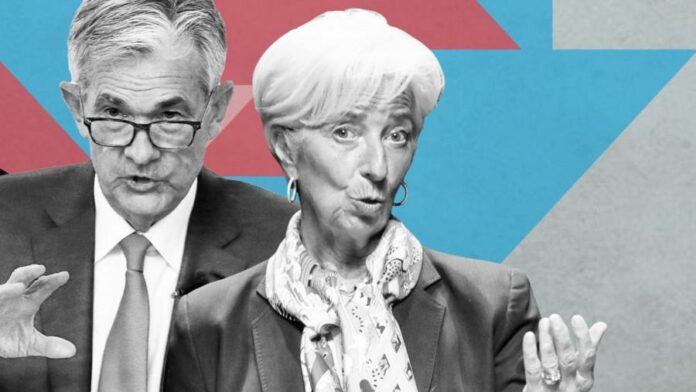Jay Powell struck a note of optimism this week when he explained why he felt able, at last, to slow the pace of rate rises. The removal of high inflation might only be in the “early stages”, the Federal Reserve chair said, but it was “gratifying” that price pressures in the US were noticeably starting to ease.
Christine Lagarde on Thursday was far gloomier, as the European Central Bank president set out the reasoning behind her rate-setters’ latest half percentage point increase. Even though headline inflation had begun to fall in the eurozone too, it was still “far too high”, and underlying price pressures remained “alive and kicking”.
While both Powell and Andrew Bailey, his counterpart at the Bank of England, signalled US and UK rates were close to their peak, Lagarde raised the near-certain prospect of another half-point rise in March — and hinted strongly that eurozone borrowing costs would need to rise further beyond that.
“The ECB statement confirms that the European Central Bank is the most hawkish of the majors at present,” said Krishna Guha, of Evercore ISI, a research firm.
The gap between rate-setters, after months of central banks on both sides of the Atlantic imposing bumper rate rises, is partly explained by the ECB’s decision to wait longer before beginning to tighten. Even if March’s rise does go ahead, the ECB’s deposit rate, at 3 per cent — up from the current level of 2.5 per cent, would remain lower than its equivalents in the US and the UK.
The BoE’s tenth consecutive rate increase on Thursday took benchmark borrowing costs to 4 per cent, but the central bank dropped its previous guidance that it would continue to act “forcefully” to contain inflation, simply saying it would act again if there was evidence of more persistent price pressures.
After Wednesday’s quarter-point increase, the US federal funds rate now hovers between a target range of 4.50 per cent to 4.75 per cent. Powell said in the post-meeting press conference that, while he would be “cautious about declaring victory”, he saw a path to bringing inflation back to target without a “really significant economic decline”.
Fed officials’ latest December projections show the policy rate would need to surpass 5 per cent and remain there throughout 2023 to bring inflation down to 2 per cent. When asked if those projections could be upgraded in March, Powell said the central bank would make “data-dependent decisions”. Some took that as a sign officials are no longer so sure rates will need to remain that high for that long.
Despite the dour message from Lagarde, market participants took the ECB’s pledge to “evaluate” the path of interest rates in May as a sign that it was preparing for a pause. “In all cases, central bank chiefs are starting to publicly entertain the notion that rates are reaching a peak,” said James Athey, investment director at Abrdn, an asset manager.
But, when asked if the ECB meant to send a signal that the rate rise planned for March would be its last for a while, Lagarde was adamant that was not the intended message. “No, no, no, no,” she said, adding that the central bank would adopt “whatever rates are needed . . . to deliver on our 2 per cent inflation target in a timely manner”. It would also keep them in restrictive territory for as long as needed — a clear signal that markets’ expectations of cuts later this year are not shared by rate-setters.
Lagarde pointed to several reasons why inflation could prove harder to tame in the eurozone than in the US, even if the risks had become more balanced than previously.
One was ongoing fiscal support for consumers and businesses, which in some cases, will not be removed automatically as energy prices fall. “It is now important to start rolling back these measures promptly,” Lagarde said, warning “a stronger monetary response” would otherwise be required.
Wage growth, although still a concern for all central banks, is slowing in the US. It is still accelerating in the eurozone as multiyear deals struck with unions are only just coming up for renegotiation. Those new deals could set pay at significantly higher levels, reflecting the sharp rise in food and energy prices workers have had to absorb over the past year.
“It is easier said than done, but it is important in those negotiations that there is a forward-looking approach to what inflation will be, and that we will return it to 2 per cent,” Lagarde said.
The ECB president also flagged the impact China’s reopening was having on global commodity prices. Unlike in the US, European goods prices continue to rise, with the effects of the pandemic on supply chains still feeding through.
“The ECB will not have a strong reason to cut rates significantly in the foreseeable future,” said Holger Schmieding, economist at Berenberg Bank.
“European inflation has lagged the dynamics for the US,” said Tiffany Wilding, an economist at Pimco, an asset manager. In the US, in contrast, she added: “The balance of risk to inflation is more balanced. Inflation is moderating and the Fed, in that environment, just doesn’t need to be as restrictive.”
Traders were unconvinced by Lagarde’s warnings, interpreting the ECB’s message as a shift to a less hawkish stance. Sandra Horsfield, economist at wealth manager Investec, said many had focused on the ECB’ describing the risks to both growth and inflation as “more balanced”.
After a year of supersized rate rises to tackle record-high inflation, the merest hints that price pressures were coming under control in 2023 proved enough to send bonds and stocks soaring.
Giles Gale, a strategist at bank NatWest Markets, said: “In this global environment not hawkish is dovish.”






